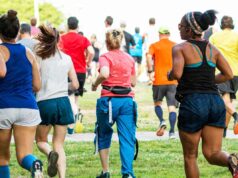The Runner’s High
Embarking on a journey through the realm of long-distance running, athletes often encounter a phenomenon as captivating as it is elusive, the runner’s high. This state of euphoric tranquility is not just a runner’s lore but a scientifically backed experience that transforms the monotonous pounding of feet on pavement into a blissful escape.
What is the Runner’s High?
The runner’s high is a fleeting, euphoric sensation experienced during or after prolonged aerobic exercise. It’s marked by a profound sense of well-being, reduced anxiety, and a diminished perception of pain. While the phenomenon was once attributed solely to the body’s release of endorphins, recent studies suggest a more complex neurochemical orchestra at play.
The Neurochemical Symphony
The euphoria known as the runner’s high arises from a symphony of neurochemicals released during sustained physical exertion:
Endorphins: These natural opioids are well-known for their pain-relieving and happiness-boosting effects.
Endocannabinoids: These are natural compounds similar to cannabis that can cross the blood-brain barrier, playing a crucial role in inducing the runner’s high, potentially even more so than endorphins. They are linked to elevated mood and reduced anxiety.
Dopamine: This neurotransmitter is associated with the brain’s reward system, contributing to feelings of pleasure and satisfaction.
Norepinephrine: It enhances alertness, arousal, and mood, playing a key role in the body’s response to stress.
How do I get the Runners High?
While the runner’s high might seem like a rare treasure, there are strategies to increase your likelihood of experiencing this coveted state:
Consistent Training: Regular, moderate to intense running sessions elevate your body’s capacity to release the neurochemicals associated with the runner’s high.
Gradual Intensity Increase: Slowly ramping up the duration and intensity of your runs can help. The runner’s high typically emerges after extended periods of exercise, often beyond 30 minutes.
Positive Mindset: A positive approach to running and setting personal milestones can amplify the enjoyment and potential for achieving a runner’s high.
Natural Settings: Running amidst nature can boost the psychological rewards of running, enhancing feelings of peace and happiness.
Community Connection: Running alongside others can provide motivation and elevate the joy of running, potentially leading to a deeper euphoric experience. See the study in our final paragraph for more on this.
Beyond the High: The Lasting Impact
The benefits of the runner’s high extend far beyond the momentary bliss:
Regular runners often report lower stress levels, attributed to the calming effects of endorphins and endocannabinoids, it serves as a potent tool against anxiety and depression, thanks in part to the neurochemical changes linked to the runner’s high.
Achieving running goals and experiencing the runner’s high can significantly enhance self-confidence and body image.
The runner’s high is a testament to the power of running as a transformative physical and mental experience. While not every run will lead to this euphoric state, the pursuit of the runner’s high can motivate us to engage regularly with this simple, yet profoundly beneficial activity. As we lace up our running shoes and hit the pavement or trails, we’re not just running towards a physical destination but towards a state of mind where we can find peace, joy, and an unparalleled sense of achievement. So, keep running, keep exploring your limits, and let the runner’s high be a beautiful, albeit elusive, part of your running journey.
For those interested in a deeper dive into the neurochemical aspects of the runner’s high, this study titled “Different psychophysiological responses to a high-intensity repetition session performed alone or in a group by elite middle-distance runners” provides valuable insights. It explores how the internal training load, which refers to the psychophysiological stress provoked by training, varies when high-intensity sessions are performed individually versus in a group. The findings suggest that training in a group can lead to different psychophysiological responses compared to training alone, despite similar external training loads. This research could offer an intriguing perspective on how social aspects of running might influence the neurochemical pathways involved in the runner’s high, highlighting the complex interplay between physical exertion, psychological states, and neurobiology in the experience of this phenomenon.
Runners World also has a great article on the Runners High here






